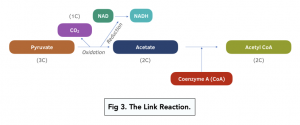The Link Reaction (A-level Biology)
The Link Reaction
What is the link reaction?
The pyruvate from glycolysis is actively transported into the mitochondrial matrix. Here, the pyruvate undergoes a transformation during a process known as the link reaction.
The end product of the link reaction, acetyl-coenzyme A, then enters into the Krebs Cycle. The purpose of the Krebs Cycle is to produce energy through the oxidation of acetyl-coenzyme A. Some ATP is made, but the main energy source is through NADH and FADH2, which can make lots of energy in the final step – oxidative phosphorylation.

Steps of Link Reaction
- Glycolysis supplies pyruvate. For every molecule of glucose that undergoes glycolysis, two molecules of pyruvate are produced. Both molecules of pyruvate enter into the mitochondrial matrix via active transport.
- Pyruvate is decarboxylated. The enzyme pyruvate decarboxylase removes a carboxyl group from pyruvate, making it lose 1C. CO2 is released.
- Pyruvate is oxidised to acetate. The enzyme pyruvate dehydrogenase oxidises pyruvate, removing an H+ and forming acetate. Just like in glycolysis, NAD is present to take up the released hydrogen, forming reduced NAD.
- Acetate combines with coenzyme A (CoA). CoA combines with acetate, making a molecule called acetyl-coenzyme A (acetyl-CoA). Acetyl-CoA will transport acetate to the Krebs cycle.

Where does the link reaction occur?
The link reaction takes place in the mitochondrial matrix in the mitochondrion. This is the space within the inner membrane and is so-called because the space is viscous, unlike the cytoplasm, which is aqueous.
Overall Equation

Products of Link Reaction
For every two molecules of pyruvate, the link reaction produces:
- 2 CO2 – CO2 is given off as a waste product
- 2 acetyl-CoA – the two molecules of acetyl-CoA enter the Krebs cycle
- 2 reduced NAD – just like glycolysis, the reduced NAD from the link reaction will transport hydrogen atoms to the mitochondrial cristae, where they will be used in oxidative phosphorylation.
The Link Reaction is the first step in cellular respiration, occurring in the mitochondria of cells. It involves the transfer of electrons from NADH and FADH2 to the electron transport chain, producing ATP.
The Link Reaction is crucial in producing ATP, which is the energy currency of cells. Without the Link Reaction, cells would not be able to produce the energy needed for processes such as muscle contraction, ion transport, and DNA synthesis.
The Link Reaction involves the transfer of electrons from NADH and FADH2 to the electron transport chain, which is made up of a series of electron carriers. This transfer of electrons creates a proton gradient across the inner mitochondrial membrane, producing ATP through the process of oxidative phosphorylation.
NADH (Nicotinamide Adenine Dinucleotide) is a molecule that carries electrons and hydrogen ions. It is produced during glycolysis and the citric acid cycle and is used as an electron donor in the Link Reaction.
FADH2 (Flavin Adenine Dinucleotide) is a molecule that also carries electrons and hydrogen ions. It is produced during the citric acid cycle and is used as an electron donor in the Link Reaction.
The electron transport chain is a series of electron carriers that accept electrons from NADH and FADH2 and transfer them through a series of redox reactions. This produces a proton gradient across the inner mitochondrial membrane, allowing for the production of ATP through oxidative phosphorylation.
Oxidative phosphorylation is the process by which ATP is produced in the mitochondria through the use of the proton gradient generated by the electron transport chain. This proton gradient drives the movement of protons back into the matrix of the mitochondria, generating ATP through the action of ATP synthase.






Still got a question? Leave a comment
Leave a comment